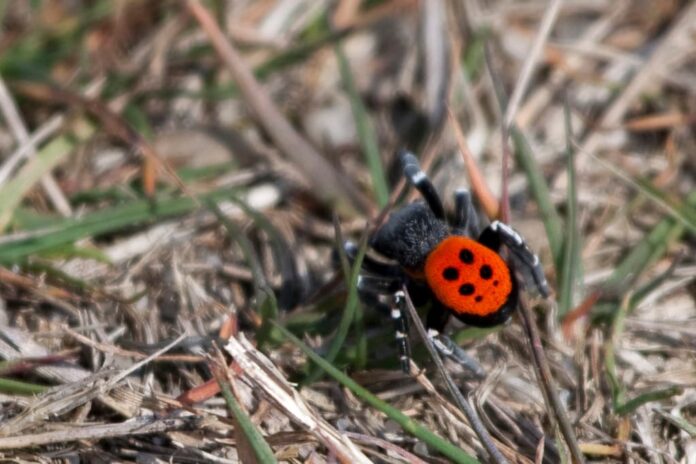The ladybird spider is not some bug that you see every day, and this is why it is special. It gets this obvious name because of the coloration of the male, and you can easily tell why. Despite being bright and pretty, the population of their 24 species is not doing well out there. Ladybird spider is classified as Endangered by the British Red Data Book; however, it is hopeful that the number will increase. For now, we can get to know them a little more so feel free to check out the information below.
1Appearance

Noticing one of these spiders can be challenging because they are super tiny, growing to only around 0.6 to 0.9 centimeters. However, the striking orange or red abdomen with 4 large black spots is hard to miss. And that is the main feature that makes ladybird spiders extremely fascinating to look at. Along with that, their black legs have white stripes that make them even more gorgeous. On top of that, only the males are gifted with such beauty as females are jet black in color. Depending on the species, some females have some yellow coloration but their color is usually dull.
2Behavior

Generally, the ladybird spiders are elusive; spending most of their lives in burrows in the ground. It takes the males around 3 years to reach maturity while females take around 4 to 5 years. Once they are ready, the males emerge from their burrow to seek mates from late April to early May. They use chemical receptors on their front legs to detect pheromones that mature females release. After mating, the males will die while the females live on to lay eggs and care for them.
It is not uncommon for spiders to have some bizarre behavior in one way or another. For the ladybird spiders, things are quite unfortunate for the mothers. A mother ladybird spider lays between 35 to 80 eggs after mating, and she cares for them by wrapping them in silk like a cocoon. The mother seals herself and the eggs into a nursery chamber in her burrow for extra protection. After a month, the eggs hatch and she feeds her spiderlings in the most sacrificial way anyone can imagine. She liquefies her internal organs and regurgitates it to feed them from her mouth which slowly results in her death a few weeks later. The bizarre part? The babies continue to suck on her until there is nothing left before they leave the web in the next spring.
3Feeding & Habitats

Surprisingly, this is the first time that something that looks this freaky does not come from Australia. Ladybird spiders are from Africa, Asia, and Europe but their population is extremely small they are considered Endangered. Where they live, they feed on various insects that walk past their burrows such as ants and beetles. They inhabit lowland heathland where south-facing sheltered slopes with well-drained sandy soil are available. This type of habitat allows them to build their silk-lined burrows they call home. The dramatic damage and loss of heathland habitat due to agriculture, development, and forestry are the main threats to these spiders. Plus with the low population, the chance of extinction of this spider species also increases.
Related Post: White-Tailed Spider Facts




